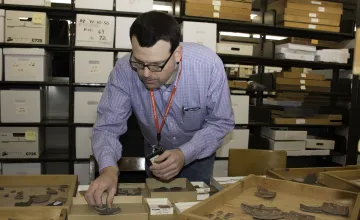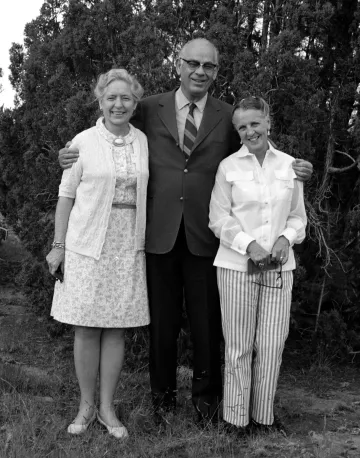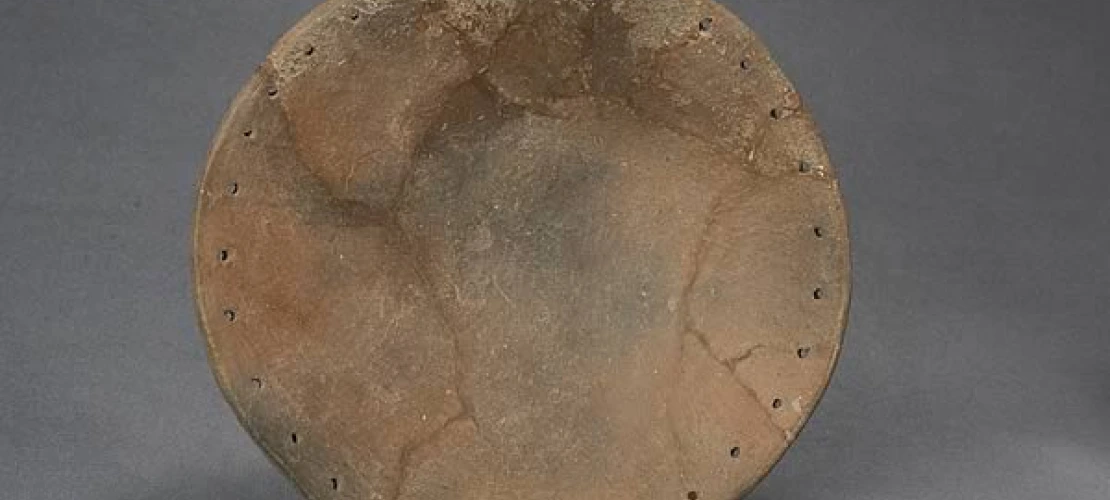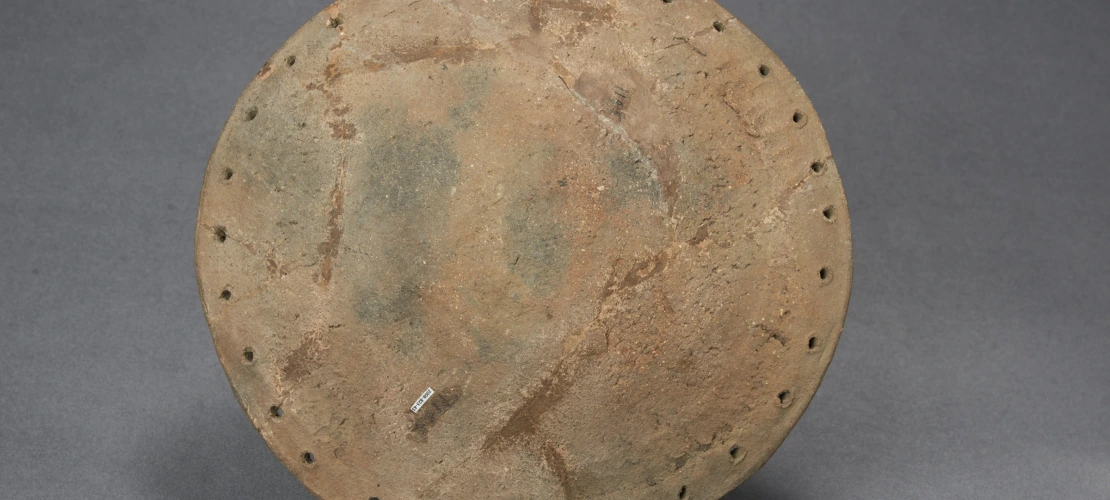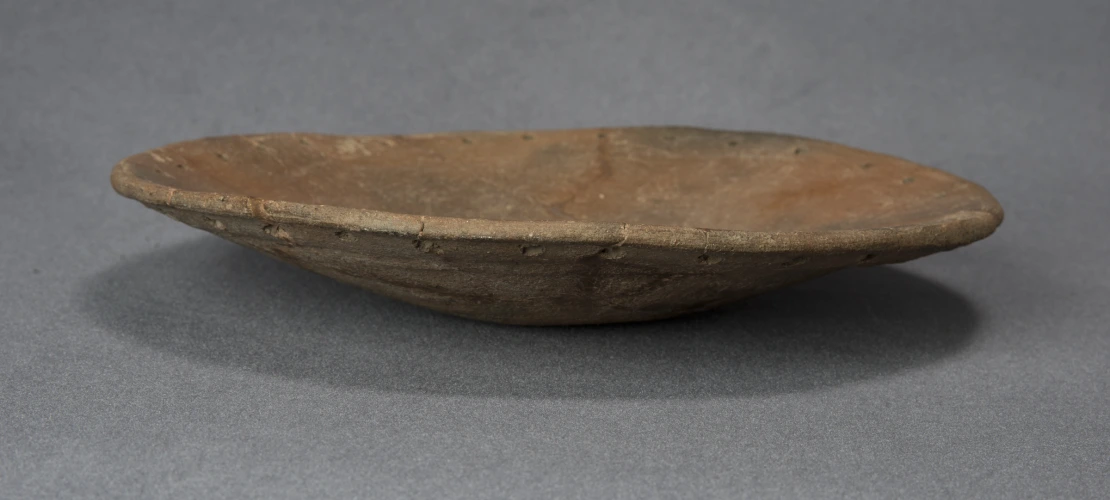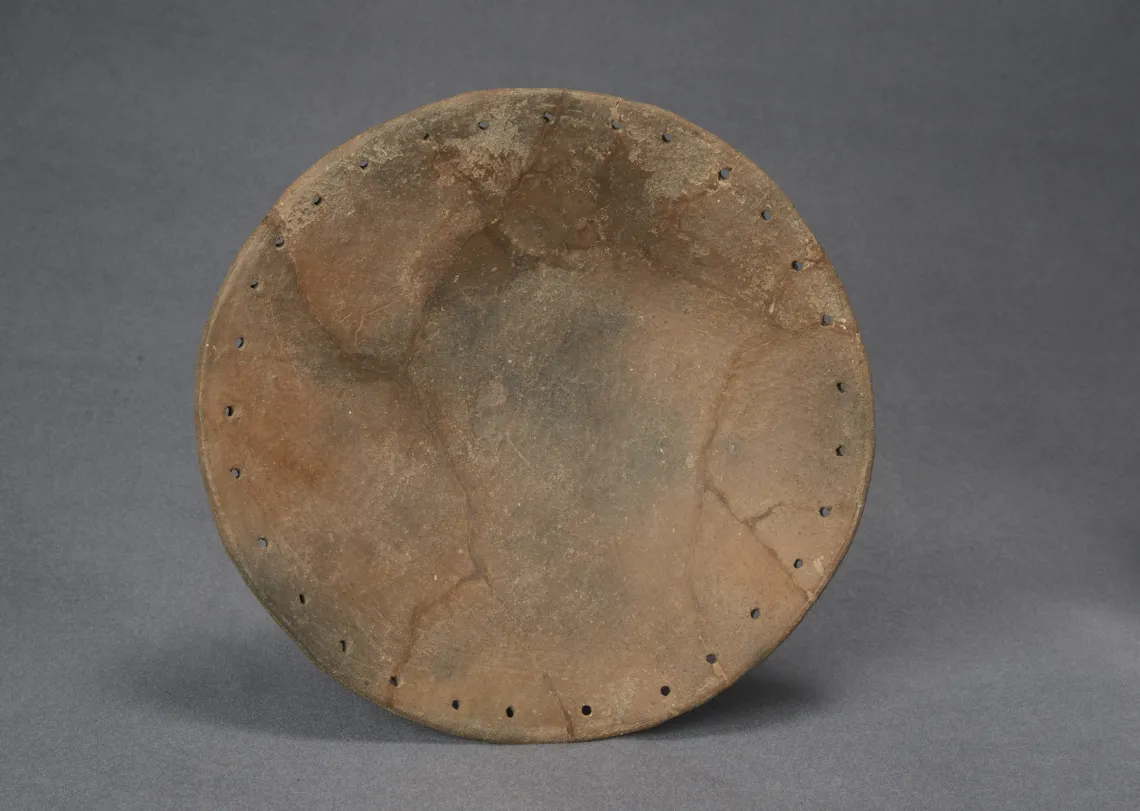
Brown Ware Perforated Plate
ca. 1275–1400 CE
Salado
Hill Top House, a.k.a. Long Wall Ruin, East Ruin (AZ V:9:68[ASM])
Globe-Miami area, Gila County, Arizona
Ceramic
Maximum diameter: 11.8 in. (30.0 cm.)
Gift of Dr. Florence Hawley Ellis
(ASM Catalog No. 2008-823-43)
The holes in these objects were punched through them, from the concave (interior) surface to the convex (exterior surface), before they were fired. Most have a single row of holes around the circumference, just below the rim, but some have two or three rows. Some exhibit patterned arrangements of holes (such as a cross dividing the plate into quadrants) as well at the usual row of perforations around the rim. Others are perforated only part of the way around the rim, or have pin-pricks where the holes ought to be. Most whole specimens of perforated plates have many "holes" that were partially or entirely plugged up when the perforating instrument was withdrawn.
Many functional explanations for the holes have been offered, including: drainage for excess moisture and improved drying of vessels being formed within the plate; creating a roughened surface—making it easier for potters, with clay-covered hands, to grip the plate; and anchor points for strings to be stretched across vessels placed inside the plate, with the strings being used as guides for the painting of designs. None of these inferences, however, has held up to scrutiny. The variability in the nature and placement of the holes led Dr. Emil Haury, former ASM Director, to suggest that they were decorative.
In any case, all available evidence supports the conclusion that perforated plates were used in pottery making. They have been found in the burials of women, alongside unfired pots, materials for making pottery, and known pottery making tools. Whole specimens have also been recovered with unfired clay, prepared for pottery making, adhering to their interior surfaces. Dozens of whole and fragmentary specimens bear fingerprints and smudges in red clay—most likely evidence that they were manipulated by a potter with slip (clay used as a decorative background color for painted designs; red clay was often used) on her hands. Many whole specimens also bear areas of heavy abrasion on their undersides, caused by repeated rotation.
Finally, this plate has a connection to Dr. Florence Hawley Ellis (1906–1991), one of the University of Arizona's most eminent alumni in the field of archaeology. Dr. Hawley Ellis was one of the first three people to receive a UA Master’s degree in archaeology (in 1928) and produced the first comprehensive guide to the identification of prehispanic pottery types found in the Four Corners states, Sonora, and Chihuahua. Her 1936 manual lists and describes nearly 200 different types.
Dr. Hawley Ellis's father, Fred G. Hawley, was a chemist who worked in the mining industry and became an associate of Harold S. Gladwin, founder of Gila Pueblo Archaeological Foundation, based in Globe. The Hawleys excavated this object from a site on private property in 1928. Beginning in the 1980s, the Hawley and Ellis families began to donate collections from this and nearby sites to ASM.
Perforated Plates
A Complicated Pattern: Pursuing the Meaning of Salado in southwestern New Mexico, from Archaeology Southwest
Before the Great Departure: The Kayenta in their Homeland, from Archaeology Southwest
Learning from Pottery, Part 2: Migration and Trade, from Archaeology Southwest
Florence Hawley Ellis
Biographical Sketch, from University of New Mexico
References
Printing this page will display URLs for links to citations.
Christenson, Andrew L.
- 1991 Identifying Pukis or Potter's Turntables at Anasazi Sites. Pottery Southwest 18(1):1-6.
- 1994 1994 Perforated and Unperforated Plates as Tools for Pottery Manufacture. In Function and Technology of Anasazi Ceramics from Black Mesa, Arizona, edited by Marion F. Smith, Jr., pp. 55-65. Center for Archaeological Investigations Occasional Paper No. 15. Center for Archaeological Investigations, Southern Illinois University, Carbondale.
Clark, Jeffery J., and Patrick D. Lyons (editors)
- 2012 Migrants and Mounds: Classic Period Archaeology of the San Pedro Valley. Anthropological Papers No. 45. Archaeology Southwest, Tucson.
Crotty, Helen K.
- 1983 Honoring the Dead: Anasazi Ceramics from the Rainbow Bridge–Monument Valley Expedition. Monograph Series No. 22. Museum of Cultural History, University of California, Los Angeles.
Di Peso, Charles C.
- 1958 The Reeve Ruin of Southeastern Arizona: A Study of a Prehistoric Western Pueblo Migration into the Middle San Pedro Valley. The Amerind Foundation No. 8. The Amerind Foundation, Inc., Dragoon, Arizona.
Haury, Emil W.
- 1931 Showlow and Pinedale Ruins. In Recently Dated Pueblo Ruins in Arizona, by Emil W. Haury and Lyndon L. Hargrave, pp. 4-79. Smithsonian Miscellaneous Collections 82(11), Smithsonian Institution, Washington, D.C.
- 1945 The Excavation of Los Muertos and Neighboring Ruins in the Salt River Valley, Southern Arizona, Based on the Work of the Hemenway Southwestern Archaeological Expedition of 1887–1888. Papers of the Peabody Museum of American Archaeology and Ethnology Vol. 24(1). Harvard University, Cambridge.
Hawley, Florence M.
- 1928 Pottery and Culture Relations in the Middle Gila. Unpublished M.A. thesis, University of Arizona, Tucson.
- 1936 Field Manual of Prehistoric Southwestern Pottery Types. University of New Mexico Bulletin No. 291. Anthropological Series 1(4). University of New Mexico, Albuquerque.
Hough, Walter
- 1903 Archeological Field Work in Northeastern Arizona: The Museum–Gates Expedition of 1901. In Report of the United States National Museum for 1901, pp. 279-358. Government Printing Office, Washington, D.C.
Judd, Neil M.
- 1930 The Excavation and Repair of Betatakin. Proceedings of the United States National Museum No. 2828. Smithsonian Institution, Washington, D.C.
Kidder, Alfred V., and Samuel J. Guernsey
- 1919 Archeological Explorations in Northeastern Arizona. Bureau of American Ethnology Bulletin 65. Government Printing Office, Washington D.C.
Lindsay, Alexander J., Jr.
- 1969 The Tsegi Phase of the Kayenta Cultural Tradition in Northeastern Arizona. Ph.D. dissertation, Department of Anthropology, University of Arizona, Tucson. UMI, Ann Arbor.
- 1987 Anasazi Population Movements to Southeastern Arizona. American Archaeology 6(3):190-198.
Lyons, Patrick D.
- 2003 Ancestral Hopi Migrations. Anthropological Papers of the University of Arizona No. 68. University of Arizona Press, Tucson.
Lyons, Patrick D., and Jeffery J. Clark
- 2012 A Community of Practice in Diaspora: The Rise and Demise of Roosevelt Red Ware. In Potters and Communities of Practice: Glaze Paint and Polychrome Pottery in the American Southwest A.D. 1200 – 1700, edited by Linda S. Cordell and Judith Habicht-Mauche, pp. 19–33. Anthropological Papers of the University of Arizona No. 75. University of Arizona Press, Tucson.
Lyons, Patrick D., J. Brett Hill, and Jeffery J. Clark
- 2011 Irrigation Communities and Communities in Diaspora. In Movement, Connectivity, and Landscape Change in the Ancient Southwest: The 20th Anniversary Southwest Symposium, edited by Margaret C. Nelson and Colleen Strawhacker, pp. 375-401. University Press of Colorado, Boulder.
Lyons, Patrick D., and Alexander J. Lindsay, Jr.
- 2006 Perforated Plates and the Salado Phenomenon. Kiva 72(1):5–54.
Mills, Barbara J.
- 1998 Migration and Pueblo IV Community Reorganization in the Silver Creek Area, East-Central Arizona, In Migration and Reorganization: The Pueblo IV Period in the American Southwest, edited by Katherine A. Spielmann, pp. 65–80. Arizona State University Anthropological Research Papers No. 51. Arizona State University, Tempe.
Neuzil, Anna A.
- 2008 In the Aftermath of Migration: Renegotiating Ancient Identity in Southeastern Arizona. Anthropological Papers of the University of Arizona No. 73. University of Arizona Press, Tucson.
Woodson, M. Kyle
- 1999 Migrations in Late Anasazi Prehistory: The Evidence from the Goat Hill Site. Kiva 65(1):63-84.
On Florence Hawley Ellis
Babcock, Barbara A., and Nancy J. Parezo
- 1988 Daughters of the Desert: Women Anthropologists and the Native American Southwest, 1880–1980. University of New Mexico Press, Albuquerque.
Frisbie, Theodore R.
- 1991 Florence Hawley Ellis 1906–1991. Kiva 57 (1):93-97.
On Hill Top House/East Ruin
Doyel, David E.
- 1978 The Miami Wash Project: Hohokam and Salado in the Globe-Miami Area, Central Arizona. Arizona State Museum Contribution to Highway Salvage Archaeology in Arizona No. 52. Arizona State Museum, University of Arizona, Tucson.
Hawley, Florence
- 1932 The Bead Mountain Pueblos of Southern Arizona. Art and Archaeology 33(5):227–236.






